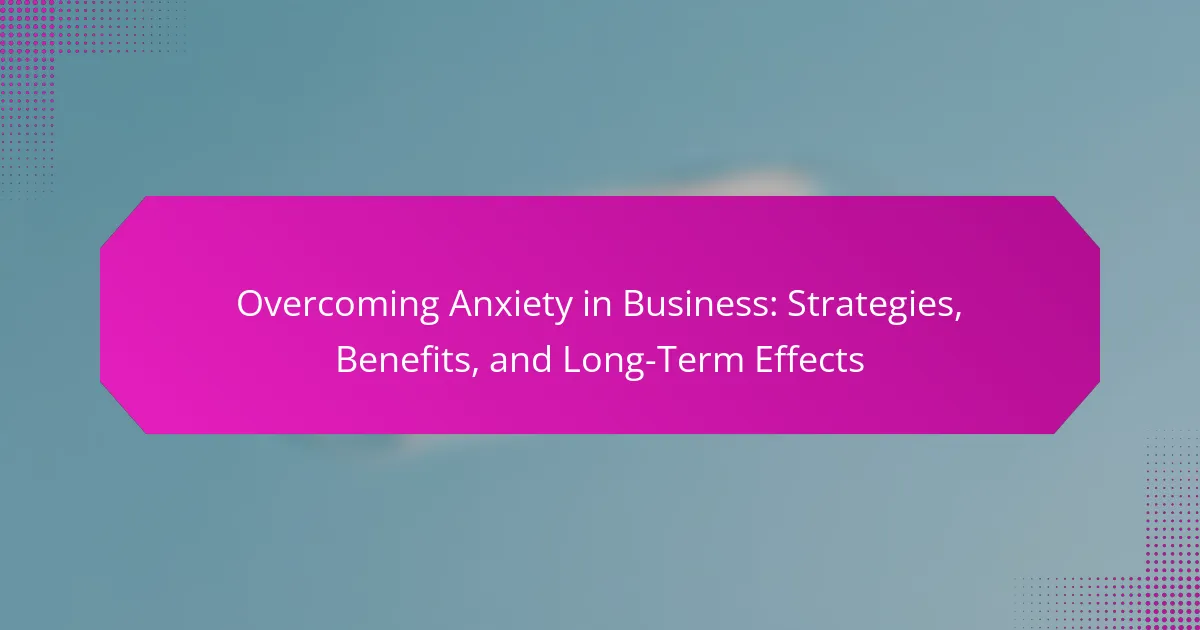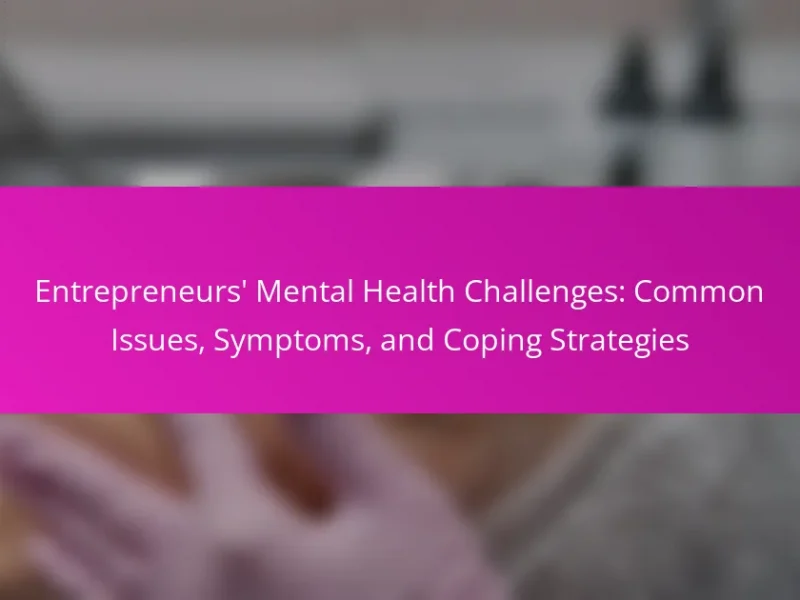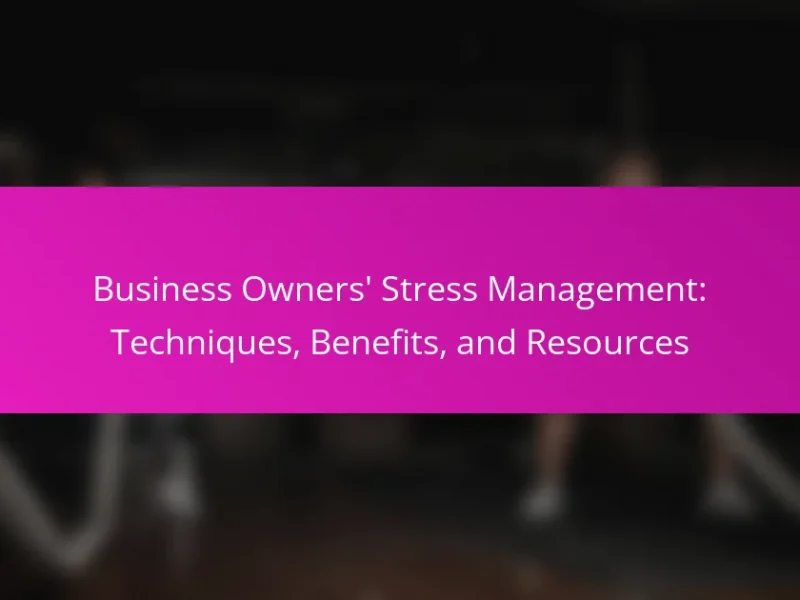Anxiety in business can severely hinder productivity and decision-making. Effective strategies to combat anxiety include fostering a supportive work environment, promoting mental health resources, and implementing stress management training. These approaches lead to improved employee well-being and collaboration. Long-term effects include a more resilient workforce and increased organizational loyalty.

What is the impact of anxiety on business performance?
Anxiety negatively impacts business performance by reducing productivity, impairing decision-making, and increasing employee turnover. Effective strategies to overcome anxiety include fostering a supportive work environment, promoting mental health resources, and implementing stress management training. These approaches lead to enhanced employee well-being, improved collaboration, and ultimately, greater business success. Long-term effects include a more resilient workforce and increased organizational loyalty.
How does anxiety affect decision-making in business?
Anxiety negatively impacts decision-making in business by impairing judgment and increasing indecision. It can lead to risk-averse behavior, resulting in missed opportunities. Strategies to overcome anxiety include mindfulness techniques and structured decision-making processes. These approaches enhance clarity and confidence, fostering better long-term business outcomes.
What are the signs of anxiety in the workplace?
Signs of anxiety in the workplace include excessive worry, difficulty concentrating, and physical symptoms like restlessness. Employees may also exhibit changes in behavior, such as withdrawing from colleagues or showing increased irritability. Recognizing these signs is essential for implementing effective strategies to overcome anxiety and promote a healthier work environment. Addressing anxiety can enhance productivity and employee well-being, leading to long-term positive effects on business performance.
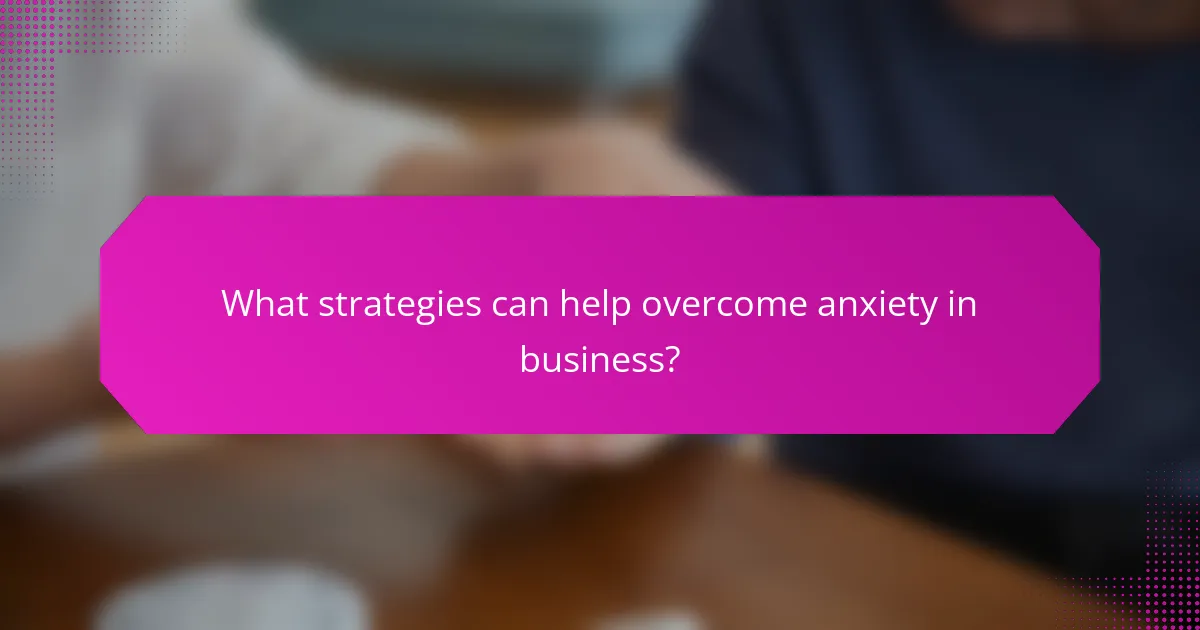
What strategies can help overcome anxiety in business?
To overcome anxiety in business, implement strategies such as mindfulness, time management, and seeking support. These approaches foster resilience, enhance focus, and improve overall well-being. Mindfulness practices reduce stress levels, while effective time management alleviates feelings of overwhelm. Engaging with mentors or peers provides valuable insights and emotional support, creating a network of encouragement. Long-term effects include improved decision-making and increased productivity, contributing to a healthier work environment.
What role does effective communication play in reducing anxiety?
Effective communication significantly reduces anxiety by fostering clarity and understanding. It enables individuals to express concerns and seek support, which can alleviate feelings of isolation. Open dialogue builds trust, creating a supportive environment that encourages collaboration. This approach not only addresses immediate anxiety but also promotes long-term emotional resilience in business settings.
How can feedback mechanisms improve workplace anxiety?
Feedback mechanisms significantly reduce workplace anxiety by fostering open communication and support. They create a safe environment where employees feel valued and heard. Regular feedback helps identify stressors, enabling timely interventions. As a result, employees experience increased job satisfaction and improved mental health. This proactive approach cultivates a culture of trust, enhancing overall productivity.
What are the benefits of time management techniques for anxiety relief?
Time management techniques significantly alleviate anxiety by providing structure and predictability. These techniques help individuals prioritize tasks, reducing feelings of overwhelm. Effective scheduling can lead to improved focus and productivity, which fosters a sense of control over one’s workload. As a result, individuals experience lower stress levels and enhanced overall well-being. Implementing these strategies consistently can lead to long-term benefits, including sustained anxiety relief and improved performance in business environments.
How can team-building activities alleviate anxiety?
Team-building activities can significantly alleviate anxiety by fostering collaboration and enhancing interpersonal relationships. These activities create a supportive environment, encouraging open communication and trust among team members. As a result, employees feel less isolated and more connected, which reduces anxiety levels. Engaging in team-building exercises also promotes problem-solving skills, enabling individuals to cope better with workplace stressors. Research indicates that teams that participate in such activities report improved morale and decreased anxiety, leading to increased productivity and job satisfaction.

What are the long-term effects of managing anxiety in business?
Managing anxiety in business leads to improved decision-making, enhanced productivity, and better team dynamics over the long term. Consistent anxiety management fosters resilience, enabling leaders to navigate challenges effectively. As a result, businesses often see increased employee satisfaction and retention. Long-term strategies, such as mindfulness and cognitive behavioral techniques, contribute to a healthier workplace culture.
How does overcoming anxiety contribute to employee retention?
Overcoming anxiety significantly enhances employee retention by fostering a supportive work environment. Employees who feel secure and valued are more likely to remain with the company. Research shows that organizations implementing mental health initiatives experience up to a 50% reduction in turnover rates. Additionally, addressing anxiety improves job satisfaction, leading to higher productivity and engagement. A positive workplace culture that prioritizes mental health can differentiate a company, making it an attractive option for talent.
What are the financial benefits of reducing anxiety in the workplace?
Reducing anxiety in the workplace leads to significant financial benefits. Companies can experience lower healthcare costs, increased productivity, and reduced employee turnover. For example, organizations that implement effective anxiety-reducing strategies see a 20% increase in employee engagement, directly impacting profitability. Additionally, reducing anxiety can enhance team collaboration, leading to more innovative solutions and improved business outcomes.

What unique approaches exist for specific industries?
Unique approaches to overcoming anxiety in business vary by industry. For instance, the tech sector often utilizes mindfulness apps to help employees manage stress, while the healthcare industry may implement peer support groups to foster open communication. In finance, cognitive-behavioral strategies are increasingly adopted to address anxiety related to high-stakes decision-making. The education sector emphasizes training programs focused on resilience and emotional intelligence. Each industry tailors its approach to fit specific challenges, enhancing overall workplace well-being.
How can tech startups address anxiety differently?
Tech startups can address anxiety differently by fostering a supportive culture and implementing innovative strategies. These include promoting open communication, offering mental health resources, and encouraging work-life balance. Implementing regular check-ins can help identify stressors early, while flexible work arrangements can alleviate pressure. The long-term effects of these strategies include enhanced employee well-being, increased productivity, and reduced turnover rates.
What strategies are effective in high-stress environments like finance?
Effective strategies in high-stress environments like finance include time management, mindfulness practices, and team collaboration. Time management enhances productivity, reducing anxiety. Mindfulness practices, such as meditation, improve focus and emotional regulation. Team collaboration fosters support and shared problem-solving, mitigating stress impacts. Implementing these strategies can lead to improved performance and long-term resilience in high-pressure situations.

What rare but impactful techniques can be employed?
Unconventional techniques such as mindfulness meditation, creative visualization, and biofeedback can significantly reduce anxiety in business. Mindfulness meditation enhances focus and emotional regulation, while creative visualization fosters positive outcomes. Biofeedback provides real-time data, allowing individuals to control physiological responses. These rare methods can lead to lasting improvements in stress management and overall performance.
How can mentorship programs specifically reduce anxiety in emerging leaders?
Mentorship programs significantly reduce anxiety in emerging leaders by providing support and guidance. They foster a safe environment for open communication, allowing leaders to share concerns and gain insights. This relationship enhances confidence and decision-making skills, leading to reduced stress levels. Additionally, mentorship cultivates a sense of belonging, which is vital for emotional well-being. As a result, participants often experience improved performance and resilience in their roles.
What role does corporate culture play in anxiety management?
Corporate culture significantly impacts anxiety management in business by fostering a supportive environment. A positive culture promotes open communication, reducing feelings of isolation among employees. This leads to increased job satisfaction and lower stress levels. Companies with strong cultures often implement wellness programs, which can further alleviate anxiety. As a result, employees are more engaged and productive, benefiting the organization in the long term.
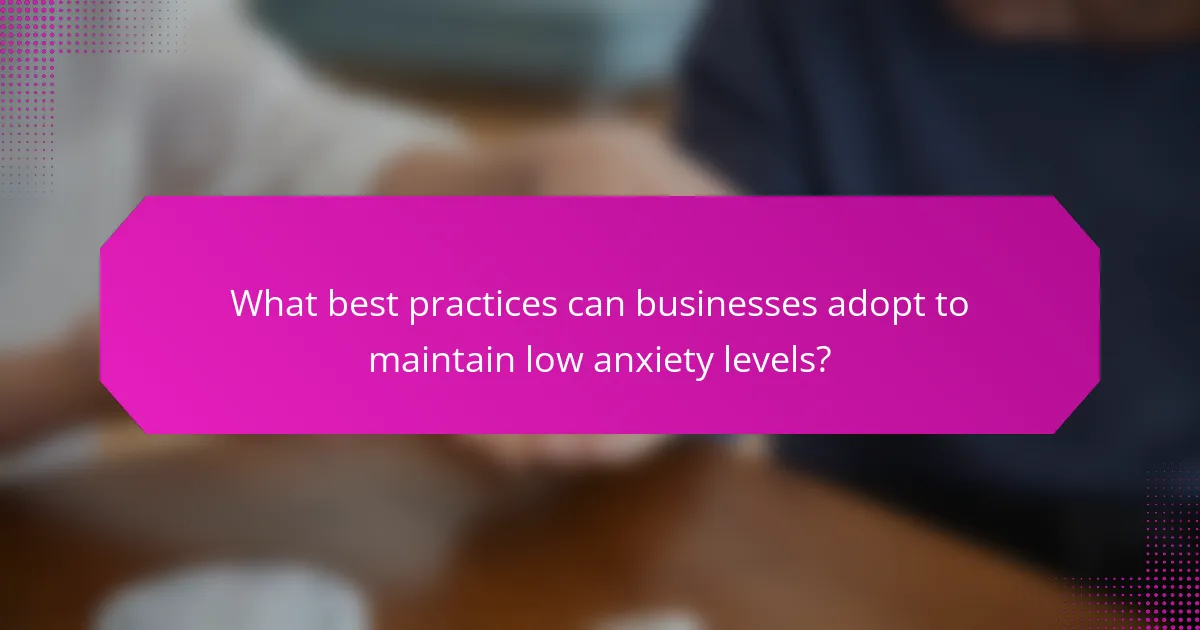
What best practices can businesses adopt to maintain low anxiety levels?
To maintain low anxiety levels, businesses can implement effective practices such as fostering open communication, encouraging work-life balance, and providing mental health resources. These strategies create a supportive environment, reduce stress, and enhance employee well-being.
Open communication allows employees to express concerns, while work-life balance initiatives help prevent burnout. Providing access to mental health resources, such as counseling services, further supports employees’ mental health. As a result, these practices contribute to a healthier workplace culture and improved productivity.
What common mistakes should businesses avoid when addressing anxiety?
Businesses should avoid minimizing employee feelings, neglecting communication, and overlooking mental health resources. These mistakes can exacerbate anxiety and hinder productivity. Prioritizing open dialogue and support fosters a healthier work environment.
How can leaders foster an open dialogue about anxiety?
Leaders can foster open dialogue about anxiety by creating a safe environment for sharing feelings. Encouraging regular check-ins and providing mental health resources can help normalize discussions around anxiety. Active listening and validating employees’ experiences are crucial for building trust. Additionally, training leaders in emotional intelligence enhances their ability to support team members effectively.
What are the top optimization tips for creating a supportive work environment?
Creating a supportive work environment reduces anxiety and enhances productivity. Focus on these top optimization tips:
1. Foster open communication to encourage employee feedback.
2. Implement flexible work arrangements to accommodate diverse needs.
3. Promote mental health resources and programs for employee support.
4. Encourage team collaboration to build strong interpersonal relationships.
5. Recognize and celebrate achievements to boost morale.
6. Provide training and development opportunities to enhance skills and confidence.
